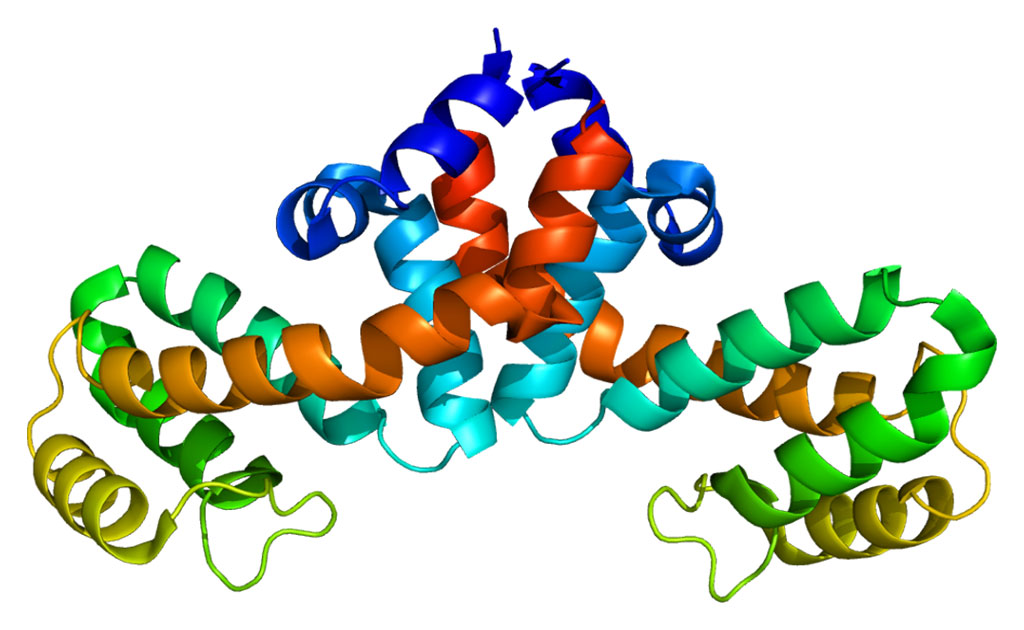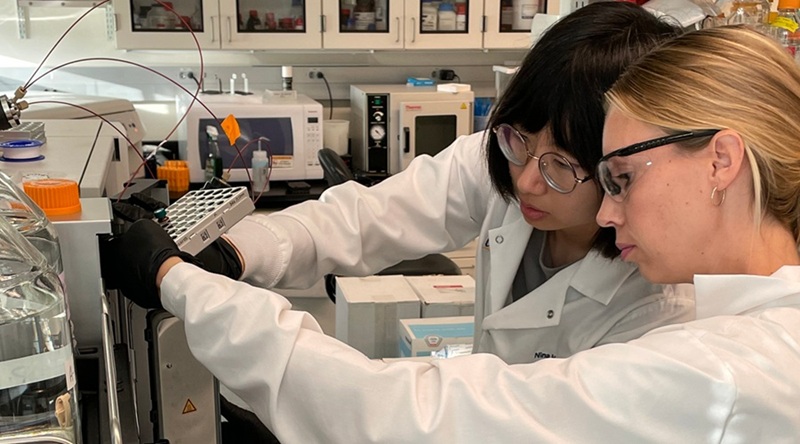Genome Analysis Predicts Likelihood of Neurodisability in Oxygen-Deprived Newborns
|
By LabMedica International staff writers Posted on 11 Aug 2020 |

Structure of the RGS1 protein (Photo courtesy of Wikimedia Commons)
A genomics-based blood test can predict likelihood that a baby suffering hypoxia at birth will suffer serious nervous disorders such as cerebral palsy or epilepsy at a later stage of development.
Hypoxic ischemic encephalopathy has many causes and is essentially the reduction in the supply of blood or oxygen to a baby's brain before, during, or even after birth. It is a major cause of death and disability, occurring in approximately two to three per 1000 births and causing around 20% of all cases of cerebral palsy.
Brain hypothermia, induced by cooling a baby to around 33 degrees Celsius for three days after birth, is a treatment for hypoxic ischemic encephalopathy. It has recently been proven to be the only medical intervention which reduces brain damage, and improves an infant's chance of survival and reduced disability.
Since a rapid and early diagnostic test to identify the encephalopathic babies at risk of adverse outcome has been lacking, investigators at Imperial College London (United Kingdom) have developed one.
The investigators theorized that a whole blood transcriptomic signature measured soon after birth would predict adverse neurodevelopmental outcome eighteen months after neonatal encephalopathy. To test this hypothesis, they performed next generation sequencing (NGS) on whole blood ribonucleic acid obtained within six hours of birth from the first 47 encephalopathic babies recruited to the Hypothermia for Encephalopathy in Low and middle-income countries (HELIX) trial. The study was conducted in Indian hospitals, where there are around 0.5-1.0 million cases of birth asphyxia per year. Blood was taken within six hours after birth, and the infants were followed until 18 months of age to identify those who developed neurodisabilities. Two infants with blood culture positive sepsis were excluded, and the data from remaining 45 were analyzed.
Results revealed that a total of 855 genes were significantly differentially expressed between the good and adverse outcome groups, of which Regulator of G-protein Signaling 1 (RGS1) and Structural Maintenance of Chromosomes Protein 4 (SMC4) were the most significant. Biological pathway analysis adjusted for gender, treatment (cooling therapy versus usual care), and estimated blood leukocyte proportions revealed over-representation of genes from pathways related to melatonin and polo-like kinase in babies with adverse outcome.
Senior author Dr. Sudhin Thayyil, professor of perinatal neuroscience at Imperial College London, said, "The results from these blood tests will allow us to gain more insight into disease mechanisms that are responsible for brain injury and allow us to develop new therapeutic interventions or improve those which are already available."
The study was published in the August 4, 2020, online edition of the journal Scientific Reports.
Related Links:
Imperial College London
Hypoxic ischemic encephalopathy has many causes and is essentially the reduction in the supply of blood or oxygen to a baby's brain before, during, or even after birth. It is a major cause of death and disability, occurring in approximately two to three per 1000 births and causing around 20% of all cases of cerebral palsy.
Brain hypothermia, induced by cooling a baby to around 33 degrees Celsius for three days after birth, is a treatment for hypoxic ischemic encephalopathy. It has recently been proven to be the only medical intervention which reduces brain damage, and improves an infant's chance of survival and reduced disability.
Since a rapid and early diagnostic test to identify the encephalopathic babies at risk of adverse outcome has been lacking, investigators at Imperial College London (United Kingdom) have developed one.
The investigators theorized that a whole blood transcriptomic signature measured soon after birth would predict adverse neurodevelopmental outcome eighteen months after neonatal encephalopathy. To test this hypothesis, they performed next generation sequencing (NGS) on whole blood ribonucleic acid obtained within six hours of birth from the first 47 encephalopathic babies recruited to the Hypothermia for Encephalopathy in Low and middle-income countries (HELIX) trial. The study was conducted in Indian hospitals, where there are around 0.5-1.0 million cases of birth asphyxia per year. Blood was taken within six hours after birth, and the infants were followed until 18 months of age to identify those who developed neurodisabilities. Two infants with blood culture positive sepsis were excluded, and the data from remaining 45 were analyzed.
Results revealed that a total of 855 genes were significantly differentially expressed between the good and adverse outcome groups, of which Regulator of G-protein Signaling 1 (RGS1) and Structural Maintenance of Chromosomes Protein 4 (SMC4) were the most significant. Biological pathway analysis adjusted for gender, treatment (cooling therapy versus usual care), and estimated blood leukocyte proportions revealed over-representation of genes from pathways related to melatonin and polo-like kinase in babies with adverse outcome.
Senior author Dr. Sudhin Thayyil, professor of perinatal neuroscience at Imperial College London, said, "The results from these blood tests will allow us to gain more insight into disease mechanisms that are responsible for brain injury and allow us to develop new therapeutic interventions or improve those which are already available."
The study was published in the August 4, 2020, online edition of the journal Scientific Reports.
Related Links:
Imperial College London
Latest BioResearch News
- Gene Panel Predicts Disease Progession for Patients with B-cell Lymphoma
- New Method Simplifies Preparation of Tumor Genomic DNA Libraries
- New Tool Developed for Diagnosis of Chronic HBV Infection
- Panel of Genetic Loci Accurately Predicts Risk of Developing Gout
- Disrupted TGFB Signaling Linked to Increased Cancer-Related Bacteria
- Gene Fusion Protein Proposed as Prostate Cancer Biomarker
- NIV Test to Diagnose and Monitor Vascular Complications in Diabetes
- Semen Exosome MicroRNA Proves Biomarker for Prostate Cancer
- Genetic Loci Link Plasma Lipid Levels to CVD Risk
- Newly Identified Gene Network Aids in Early Diagnosis of Autism Spectrum Disorder
- Link Confirmed between Living in Poverty and Developing Diseases
- Genomic Study Identifies Kidney Disease Loci in Type I Diabetes Patients
- Liquid Biopsy More Effective for Analyzing Tumor Drug Resistance Mutations
- New Liquid Biopsy Assay Reveals Host-Pathogen Interactions
- Method Developed for Enriching Trophoblast Population in Samples
- RNA-Based Test Developed for HPV Detection and Cancer Diagnosis
Channels
Clinical Chemistry
view channel
Online Tool Detects Drug Exposure Directly from Patient Samples
Doctors often rely on patient interviews and medical records to determine what medications a person has taken, but this information is frequently incomplete. People may forget drugs they used, take over-the-counter... Read more
Chemical Imaging Probe Could Track and Treat Prostate Cancer
Prostate cancer remains a leading cause of illness and death among men, with many patients eventually developing resistance to standard hormone-blocking therapies. These drugs often lose effectiveness... Read moreMolecular Diagnostics
view channel
Ultrasensitive Method Detects Low-Frequency Cancer Mutations
Liquid biopsy has emerged as a promising approach for cancer detection and treatment monitoring, although its clinical impact has been limited by the extremely low levels of tumor-derived DNA circulating in blood.... Read more
Blood Test Enables Non-Invasive Endometriosis Detection
Endometriosis is a chronic, complex, yet relatively common gynecological disorder, reportedly affecting 1 in 10 adult and adolescent women. Endometriosis causes tissue similar to the lining of the uterus... Read moreHematology
view channel
MRD Tests Could Predict Survival in Leukemia Patients
Acute myeloid leukemia is an aggressive blood cancer that disrupts normal blood cell production and often relapses even after intensive treatment. Clinicians currently lack early, reliable markers to predict... Read more
Platelet Activity Blood Test in Middle Age Could Identify Early Alzheimer’s Risk
Early detection of Alzheimer’s disease remains one of the biggest unmet needs in neurology, particularly because the biological changes underlying the disorder begin decades before memory symptoms appear.... Read more
Microvesicles Measurement Could Detect Vascular Injury in Sickle Cell Disease Patients
Assessing disease severity in sickle cell disease (SCD) remains challenging, especially when trying to predict hemolysis, vascular injury, and risk of complications such as vaso-occlusive crises.... Read more
ADLM’s New Coagulation Testing Guidance to Improve Care for Patients on Blood Thinners
Direct oral anticoagulants (DOACs) are one of the most common types of blood thinners. Patients take them to prevent a host of complications that could arise from blood clotting, including stroke, deep... Read moreImmunology
view channel
Routine Blood Test Can Predict Who Benefits Most from CAR T-Cell Therapy
CAR T-cell therapy has transformed treatment for patients with relapsed or treatment-resistant non-Hodgkin lymphoma, but many patients eventually relapse despite an initial response. Clinicians currently... Read more
New Test Distinguishes Vaccine-Induced False Positives from Active HIV Infection
Since HIV was identified in 1983, more than 91 million people have contracted the virus, and over 44 million have died from related causes. Today, nearly 40 million individuals worldwide live with HIV-1,... Read more
Gene Signature Test Predicts Response to Key Breast Cancer Treatment
DK4/6 inhibitors paired with hormone therapy have become a cornerstone treatment for advanced HR+/HER2– breast cancer, slowing tumor growth by blocking key proteins that drive cell division.... Read more
Chip Captures Cancer Cells from Blood to Help Select Right Breast Cancer Treatment
Ductal carcinoma in situ (DCIS) accounts for about a quarter of all breast cancer cases and generally carries a good prognosis. This non-invasive form of the disease may or may not become life-threatening.... Read moreMicrobiology
view channel
Blood-Based Diagnostic Method Could Identify Pediatric LRTIs
Lower-respiratory tract infections (LRTIs) are a leading cause of illness and death worldwide, and pneumonia is the leading infectious cause of death in children under five, claiming the lives of over... Read more
Rapid Diagnostic Test Matches Gold Standard for Sepsis Detection
Sepsis kills 11 million people worldwide every year and generates massive healthcare costs. In the USA and Europe alone, sepsis accounts for USD 100 billion in annual hospitalization expenses.... Read moreRapid POC Tuberculosis Test Provides Results Within 15 Minutes
Tuberculosis remains one of the world’s deadliest infectious diseases, and reducing new cases depends on identifying individuals with latent infection before it progresses. Current diagnostic tools often... Read more
Rapid Assay Identifies Bloodstream Infection Pathogens Directly from Patient Samples
Bloodstream infections in sepsis progress quickly and demand rapid, precise diagnosis. Current blood-culture methods often take one to five days to identify the pathogen, leaving clinicians to treat blindly... Read morePathology
view channel
Rapid Low-Cost Tests Can Prevent Child Deaths from Contaminated Medicinal Syrups
Medicinal syrups contaminated with toxic chemicals have caused the deaths of hundreds of children worldwide, exposing a critical gap in how these products are tested before reaching patients.... Read more
Tumor Signals in Saliva and Blood Enable Non-Invasive Monitoring of Head and Neck Cancer
Head and neck cancers are among the most aggressive malignancies worldwide, with nearly 900,000 new cases diagnosed each year. Monitoring these cancers for recurrence or relapse typically relies on tissue... Read more
Common Health Issues Can Influence New Blood Tests for Alzheimer’s Disease
Blood-based tests for Alzheimer’s disease are transforming diagnosis by offering a simpler alternative to spinal taps and brain imaging. However, many people evaluated at memory clinics also live with... Read more
Blood Test Formula Identifies Chronic Liver Disease Patients with Higher Cancer Risk
Chronic liver disease affects millions worldwide and can progress silently to hepatocellular carcinoma (HCC), one of the deadliest cancers globally. While surveillance guidelines exist for patients with... Read moreTechnology
view channel
Machine Learning Models Diagnose ALS Earlier Through Blood Biomarkers
Amyotrophic lateral sclerosis (ALS) is a rapidly progressive neurodegenerative disease that is notoriously difficult to diagnose in its early stages. Early symptoms often overlap with other neurological... Read more
Artificial Intelligence Model Could Accelerate Rare Disease Diagnosis
Identifying which genetic variants actually cause disease remains one of the biggest challenges in genomic medicine. Each person carries tens of thousands of DNA changes, yet only a few meaningfully alter... Read moreIndustry
view channel
Abbott Acquires Cancer-Screening Company Exact Sciences
Abbott (Abbott Park, IL, USA) has entered into a definitive agreement to acquire Exact Sciences (Madison, WI, USA), enabling it to enter and lead in fast-growing cancer diagnostics segments.... Read more








 (3) (1).png)










